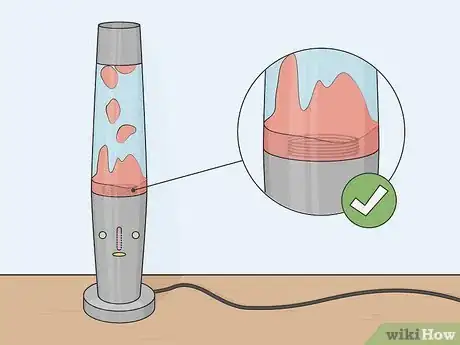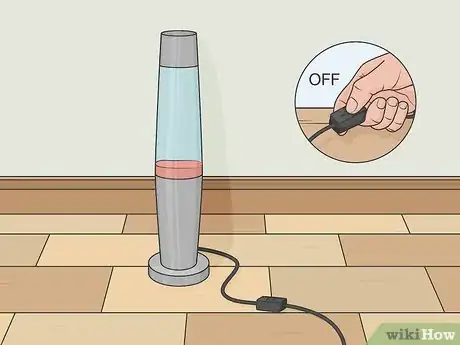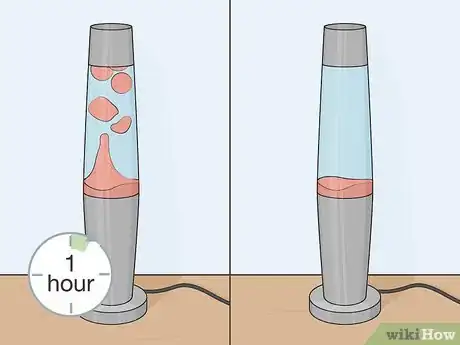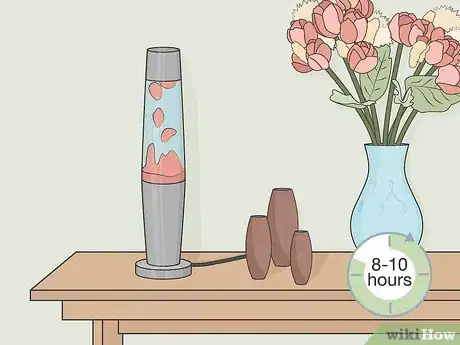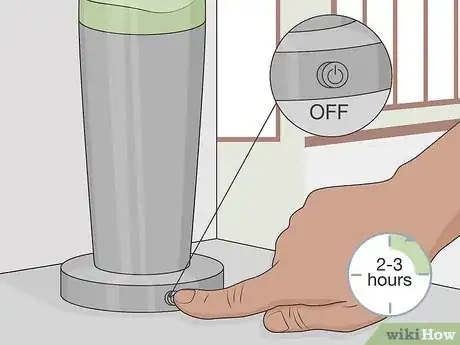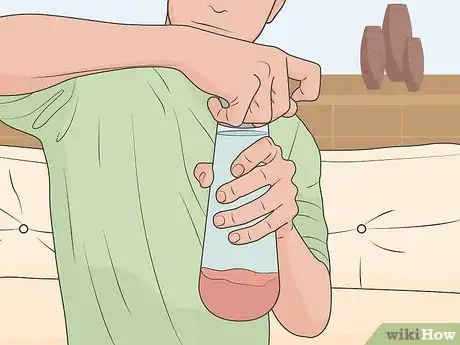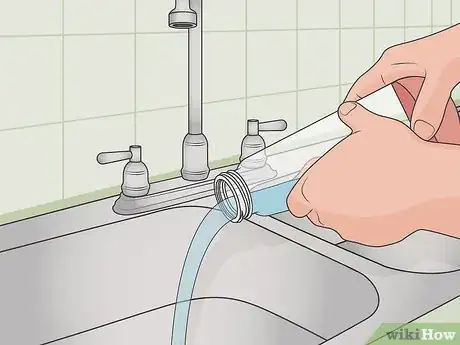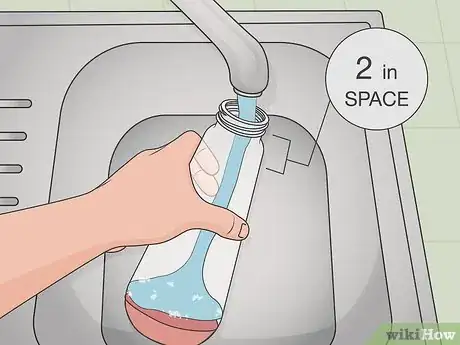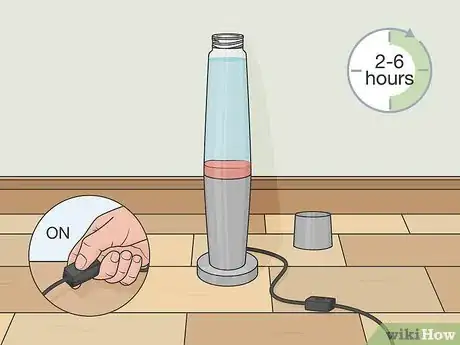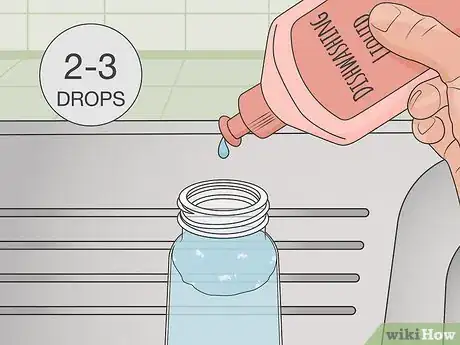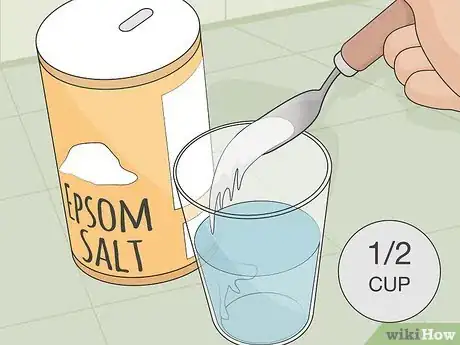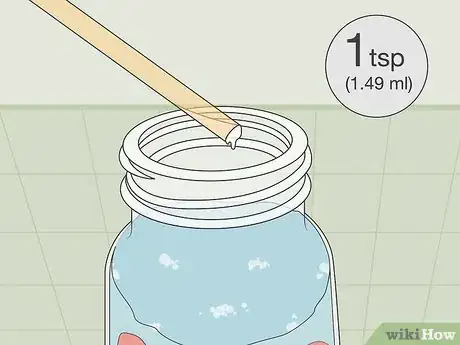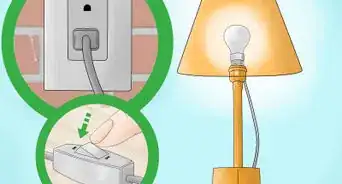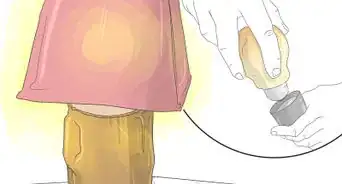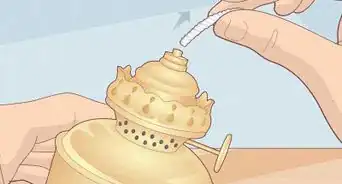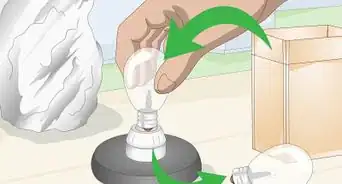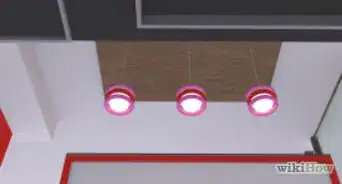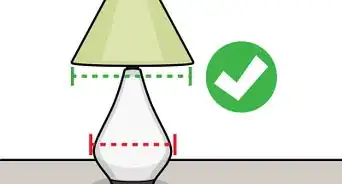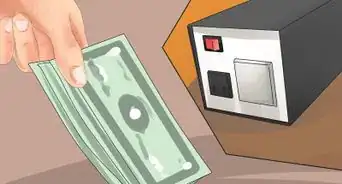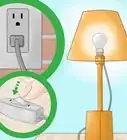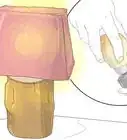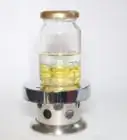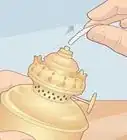This article was co-authored by wikiHow Staff. Our trained team of editors and researchers validate articles for accuracy and comprehensiveness. wikiHow's Content Management Team carefully monitors the work from our editorial staff to ensure that each article is backed by trusted research and meets our high quality standards.
There are 13 references cited in this article, which can be found at the bottom of the page.
This article has been viewed 112,849 times.
Learn more...
A lava lamp can lend a relaxing glow and a look of retro fun to just about any space. After a while, though, you may notice that the “lava” in your lamp isn’t flowing the way it used to, or that clumping or clouding are taking away from the lamp’s aesthetic. When these problems arise, it can be helpful to know how to clear them up—literally. Fortunately, troubleshooting most common lava lamp issues is a breeze.
Steps
Getting a Stalled Lamp Flowing Again
-
1Check to see whether the metal heating coil is in the correct position. When your lamp is working as it should, the ring-shaped, free-floating coil will lie flat at the bottom of the bottle, or the transparent container that holds the suspension fluid. If it becomes displaced, however, it will no longer be able to transfer heat efficiently, which can sometimes cause the wax to slow down or stop altogether.[1]
- A displaced heating coil may appear slanted or stand up on its side. This typically happens when the coil becomes encased in the fallen wax as it dries, causing it to rest at an uneven angle.
- The heating coil’s job is to amplify the heat generated by the internal heating element in the base, which warms the wax from below and helps it melt faster.[2]
-
2Turn off your lamp and allow it to cool down for 30 minutes to an hour. Leave the lamp sitting undisturbed until the bottle reaches a safe handling temperature. At this point, you’ll be able to take hold of it and make the necessary adjustments without worrying about burning yourself.[3]
- It may still be a good idea to wear gloves or wrap your lava lamp in a thick towel while manipulating it, just in case.
Tip: Common hang-ups like clumping and doming are often the result of overheating. By simply giving your lamp a chance to cool down, these issues will most likely sort themselves out.[4]
Advertisement -
3Move the lamp around gently until the coil is lying flat again. Start by twirling the bottle in its base or rocking it from side to side. If that doesn’t do the trick, carefully pick it up and tilt it at a more extreme angle. Once you’ve righted the coil, you can turn the lamp back on and enjoy its relaxing glow.[5]
- Avoid shaking or jostling the lamp too hard, as this can cause clouding, which is somewhat tougher to fix.
- The coil is smaller in diameter than bottom of the bottle, so you should have no problem getting it back in its proper position once the wax has warmed up enough to melt partially.
Dealing with Minor Clouding
-
1Switch off your lava lamp and allow the wax to settle completely. With most styles of lamps, this will usually take somewhere around 6-8 hours. Your best bet is to let it sit overnight and come back to it sometime the next day.[6]
- Clouding occurs when trace amounts of oils from the wax begin seeping into the surrounding liquid. This can happen if you shake your lamp or knock it over accidentally.
- To avoid overturning your lava lamp, situate it in an out-of-the-way spot where you or someone else will be less likely to bump into it.
-
2Turn on the lamp for about an hour, then turn it off and let it cool again. This will give the wax just enough time to melt just a bit. The idea is to get it nice and soft so that when it settles again, all the loose little particles floating around in the liquid will fuse back into one big blob.[7]
- Be sure to give the wax plenty of time to resettle after the initial burst of heat. If you turn it back on prematurely, you may just end up having to do the whole thing over again.
- In some cases, turning off the lamp for 24 hours and turning it back on may also take care of the problem.[8]
-
3Run the lamp continuously for 8-10 hours. With any luck, the repeated heating and cooling will have reintegrated the wax, leaving the suspension liquid crystal clear. If your lamp still looks cloudy afterwards, you may have no other option than to buy a new one or replace the tainted liquid yourself.[9]
- Never leave your lava lamp on for more than 8-10 hours at a time. Overheating can present a serious risk of fire.[10]
Tip: If you want to enjoy your lamp’s mesmerizing aura 24/7, see if your unit has a built-in timer that you can set to turn it off automatically, or invest in a second lamp that you can alternate with the first.[11]
Replacing Dirty or Clouded Lamp Liquid
-
1Turn off your lava lamp and let it sit for 2-3 hours. It’s important to make sure that the wax inside has had a chance to cool completely prior to operating on your lamp. Otherwise, you could end up accidentally pouring it out when you go to empty the bottle.[12]
- While you’re at it, go ahead and unplug your lamp as well to ensure that there’s no power running to it.
- Make sure that all of the wax is settled at the bottom of the lamp before you continue.
-
2Unscrew or pry off the top of the lamp. Some lamps have threaded tops that you can simply twist off by hand. Others have flat or bottle cap-style tops that will be a little more difficult to remove. You may need to grab an adjustable wrench, a pair of pliers, or a bottle opener to give yourself some extra leverage.[13]
- Brace the lamp firmly with your free hand while you work on the top to prevent the liquid inside from sloshing out when it finally pops off.
Warning: Removing the top from your lava lamp could void your warranty and ruin your chances of getting a free or discounted replacement should your repairs be unsuccessful.
-
3Pour out the old liquid without disturbing the solidified wax. Drain the liquid into the sink slowly. Once the lamp is completely empty, run 3–4 fluid ounces (89–118 mL) of cold water down the interior side of the bottle, swish it around gently for a few seconds, and drain it again.[14]
- Don’t shake the lamp up and down, as this could break up the wax.
- You may need to repeat the rinsing process several times to flush out every last bit of lingering oil residue.
- Both the liquid and the wax inside a lava lamp are non-toxic, so there's no need to wear gloves or be overly cautious here. Just be sure to wash your hands afterwards.[15]
-
4Refill the bottle with fresh water, leaving 2 inches (5.1 cm) of space at the top. As you did when rinsing, run the down the side of the bottle to avoid breaking up the hardened wax. Stop before you reach the top—you’ll be adding a couple more ingredients, so save some room.[16]
- It’s best to use distilled or filtered water for this step, since both types of water tend to be more pure than ordinary tap water. However, tap water will also work if it’s all you have.
- If you opt to use tap water, be aware that it contains small amounts of chemicals and minerals that may affect the behavior of the wax once you get the lamp going again.
-
5Turn on the lamp and allow it to warm up for 2-6 hours. Now, return your still-topless lamp to its base, plug it back in, and switch it on to get some heat running through it. For the last few steps, you’ll need the wax to be melted in order to observe whether it’s behaving properly.[17]
- Most lava lamps reach ideal flow temperature in around 2-3 hours, but your lamp may need more or less time, depending on its size, volume, and frequency of use.[18]
- The lack of a top won't affect your lava lamp's performance. It's just there to hold the liquid in.
-
6Squeeze 2-3 drops of clear liquid dish soap into the water in the bottle. Easy does it here—a little bit of soap goes a long way. You just need enough detergent to promote separation between the oily wax and the surrounding fluid. Adding too much could lead to bubbling, foaming, excessive separation or other visual defects.[19]
- A clear variety of soap will prevent any unexpected and undesired changes to your lamp’s colors.
-
7Dissolve ½ cup (150 g) of Epsom salt in a small glass of warm water. Fill the glass first, then measure out your salt and sift them in gradually as you stir. Keep stirring the mixture until the salt has dissolved entirely. The resulting solution should appear somewhat white in color.[20]
- For this project, you'll want to use pure, all-natural Epsom salt, without any added colors, fragrances, or essential oils.
- Steer clear of regular table salts, and any type of iodized salt, for that matter. These will just cause the lamp liquid to become cloudy again.[21]
-
8Use a straw or pipette to slowly add the solution until the wax flows normally. Drop in about 1 teaspoon (4.9 mL) at a time, then wait 3-5 minutes to see how the wax reacts. The salt will gradually increase the density of the water, encouraging the less dense wax to rise. After a little while, your lava lamp should be flowing just like the day you got it![22]
- You can also use a teaspoon to transfer the salt solution if you don’t happen to have a pipette or drinking straw handy.[23]
- This is the most time-consuming step, but also the most important, so have patience and be careful not to overdo it.
-
9Replace your lamp’s top when you’re happy with the way things are moving. If it's the kind with threads, all you have to do is screw it back on snugly. If it's a flat or bottle cap-style top, you may need to use a dab of super glue to help secure it since you had to force it off earlier. All done![24]
- Leave your lamp running while the glue dries. Most super glues cure faster when exposed to heat.
Warnings
- To minimize the danger of fire, make sure your lava lamp is a safe distance away from flammable items like curtains, tablecloths, and loose papers.⧼thumbs_response⧽
- Issues like severe clouding, defective heating elements, damaged electrical components, and cracked or broken bottles will likely be beyond the average user's ability to repair at home. Should you encounter any of these issues, consider buying a new lamp.⧼thumbs_response⧽
- Never touch your lamp when it's running or has only recently been turned off. Doing so could give you a nasty burn.⧼thumbs_response⧽
Things You’ll Need
Getting a Stalled Lamp Flowing Again
- Gloves or thick towel (optional)
Replacing Dirty or Clouded Lamp Liquid
- Distilled or filtered water
- Clear liquid dish soap
- Epsom salt
- Drinking glass
- Spoon
- Straw, pipette, or teaspoon
- Adjustable wrench, pliers, or bottle opener (optional)
- Tap water (optional)
- Super glue (optional)
References
- ↑ https://www.lavalamp.com/faq/
- ↑ https://images-na.ssl-images-amazon.com/images/I/61U1U3sts6L.pdf
- ↑ https://homesteady.com/12268771/what-are-the-dangers-of-lava-lamps
- ↑ https://www.bestadvisor.com/how-to/how-to-fix-lava-lamp-problems
- ↑ https://www.youtube.com/watch?v=4vlI7tZT9e4&feature=youtu.be&t=28
- ↑ https://www.lavalamp.com/faq/
- ↑ https://www.bestadvisor.com/how-to/how-to-fix-lava-lamp-problems
- ↑ https://youtu.be/4vlI7tZT9e4?t=42
- ↑ https://www.lavalamp.com/faq/
- ↑ https://homesteady.com/12268771/what-are-the-dangers-of-lava-lamps
- ↑ https://www.onlamps.com/are-lava-lamps-safe-to-leave-on-all-night/
- ↑ https://www.onlamps.com/how-to-fix-a-lava-lamp-after-shaking-it/
- ↑ http://www.moltenmeditation.com/lava-lamps.html
- ↑ http://www.moltenmeditation.com/lava-lamps.html
- ↑ https://homesteady.com/12268771/what-are-the-dangers-of-lava-lamps
- ↑ https://www.youtube.com/watch?v=E1cLubV7vuc&feature=youtu.be&t=119
- ↑ https://www.youtube.com/watch?v=4vlI7tZT9e4&feature=youtu.be&t=92
- ↑ https://www.lavalamp.com/faq/
- ↑ http://www.moltenmeditation.com/lava-lamps.html
- ↑ http://www.moltenmeditation.com/lava-lamps.html
- ↑ https://www.onlamps.com/how-to-fix-a-lava-lamp-after-shaking-it/
- ↑ https://www.youtube.com/watch?v=lieNDcL_SKo&feature=youtu.be&t=200
- ↑ https://www.youtube.com/watch?v=E1cLubV7vuc&feature=youtu.be&t=202
- ↑ http://www.moltenmeditation.com/lava-lamps.html
